10 Space-Saving Vertical Herb Garden Ideas for Small Balconies
1. Hanging Pocket Organizers
Transform a fabric shoe organizer into a space-efficient herb garden. Mount it on your balcony wall or railing, fill each pocket with soil, and plant different herbs in each compartment. This vertical solution utilizes wall space that would otherwise go unused and allows you to grow up to 20 different herbs in a single organizer.
2. Tiered Plant Stands
Invest in a multi-level plant stand that creates vertical growing space while maintaining a small footprint. These stands can hold multiple pots and elevate plants for better sunlight exposure. A three-tier stand typically accommodates 9-12 herb plants while taking up less than two square feet of floor space.
3. Railing Planters
Maximize your balcony perimeter with railing-mounted planters that hang on the outside of your space. These specially designed containers attach securely to railings without taking up precious floor area. Choose adjustable models that can fit different railing widths for a customized setup.
4. Repurposed Pallets
Convert a wooden pallet into a vertical herb garden by adding backing, lining with industry fabric, and filling with soil. Mount it on your balcony wall to create a rustic, space-saving display that can host 8-10 different herbs. Sand and seal the wood beforehand to protect against moisture damage.
5. Stackable Planters
Try self-watering stackable planters that build upward instead of outward. These modular systems often include water reservoirs that minimize maintenance while maximizing growing space. A typical tower can accommodate 15+ plants while occupying only one square foot of floor space.
6. Trellis Grid Systems
Install a metal or wooden trellis grid on your balcony wall to support climbing herbs like thyme and oregano. Add small pots at the base and train the plants to grow upward. This method creates a living wall effect while keeping your floor space completely open.
7. Magnetic Planter Tiles
For metal railings or surfaces, magnetic planter tiles offer an innovative solution. These small containers attach magnetically to any ferrous surface and can be arranged in countless configurations. Rearrange them seasonally to optimize sun exposure for different herbs throughout the year.
8. Vertical Hydroponic Systems
Explore space-efficient hydroponic towers that grow herbs without soil. These self-contained systems often include built-in lighting and water circulation, making them perfect for balconies with limited sunlight. Modern units can grow up to 30 plants in a 2-square-foot area while using 90% less water than traditional gardening.
9. Hanging Mason Jar Planters
Create a charming vertical garden using mason jars mounted on a wooden board. Secure the jars with metal clamps, fill with soil, and plant individual herbs in each jar. Label each container with chalkboard paint for an organized and decorative display that takes up zero floor space.
10. Window Box Herb Ladder
Build or purchase a ladder-style plant stand that leans against your balcony wall. Each rung holds a window box-style planter, creating multiple growing levels in a compact footprint. This design allows you to grow 20+ herbs in less than three square feet while providing easy access for harvesting.
How to Choose the Right Containers for Your Balcony Herb Garden
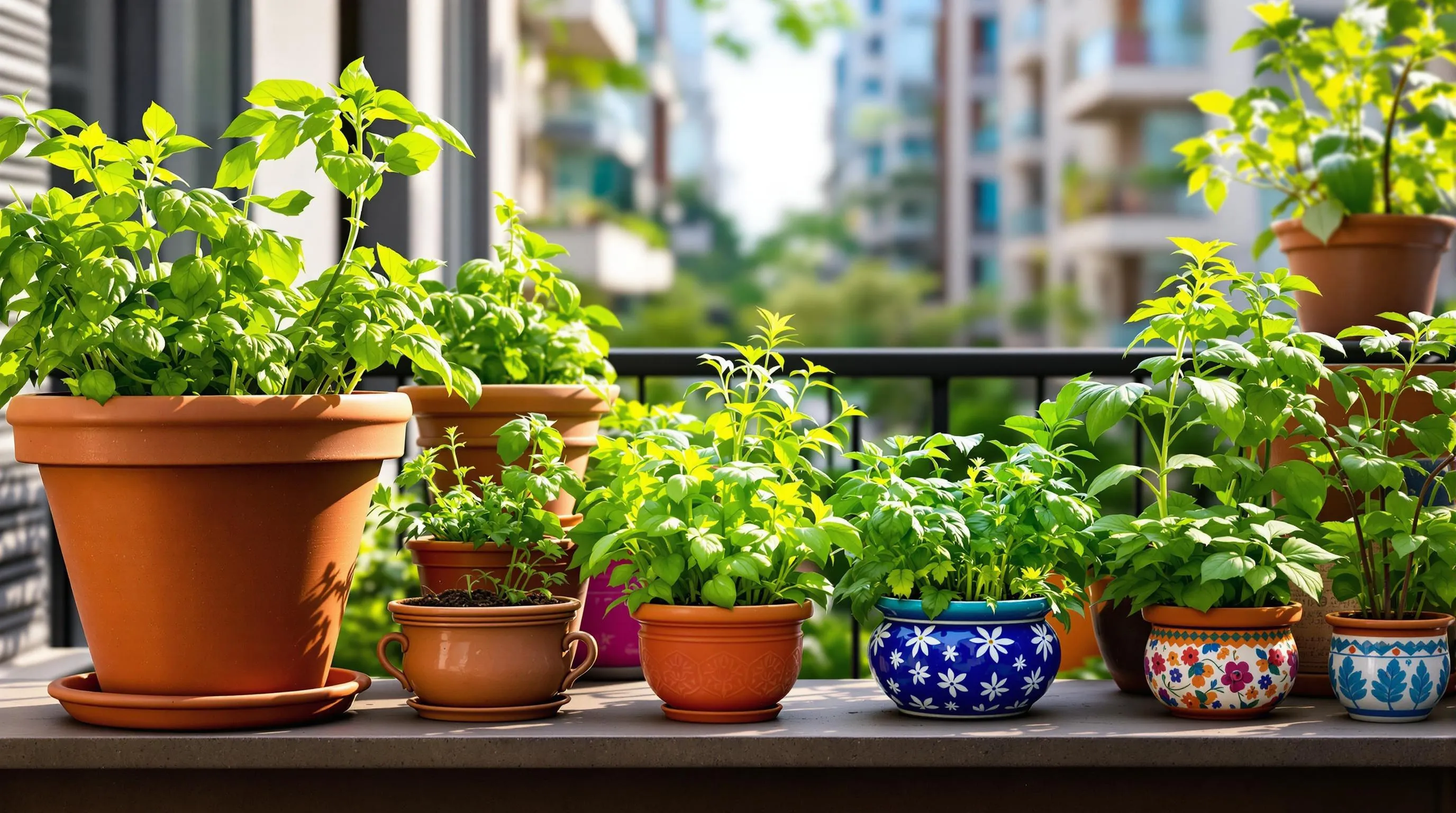
Selecting appropriate containers is crucial for the success of your balcony herb garden. The right pots will not only support healthy plant growth but also complement your outdoor space while addressing practical considerations like space limitations and maintenance requirements.
Self-Watering Containers for Busy Gardeners
Self-watering containers are perfect for time-strapped urban gardeners who can’t maintain a regular watering schedule. These innovative planters feature a reservoir at the bottom that stores water, allowing plants to absorb moisture as needed through capillary action. Most self-watering pots include a water level indicator to help you monitor when it’s time to refill. Herbs like mint, basil, and parsley thrive in these containers as they prefer consistent moisture. For optimal results, choose self-watering planters with at least 6-8 inches of depth to accommodate herb root systems and ensure the container has proper drainage holes to prevent root rot during rainy periods.
Decorative Pots That Enhance Your Outdoor Space
Decorative containers serve the dual purpose of growing herbs while adding visual appeal to your balcony. Terra cotta pots offer a classic Mediterranean look and provide excellent breathability for herb roots, while ceramic planters in vibrant colors can create eye-catching focal points. Consider matching your containers to your balcony’s color scheme or creating contrast with complementary hues. Galvanized metal tubs and vintage containers like repurposed teapots or colanders add character and conversation starters. When selecting decorative pots, ensure they’re at least 6 inches deep with drainage holes and saucers to protect your balcony surface. Group containers of varying heights and sizes to create visual interest while maintaining adequate spacing for air circulation between your herbs.
Essential Herbs That Thrive in Balcony Environments
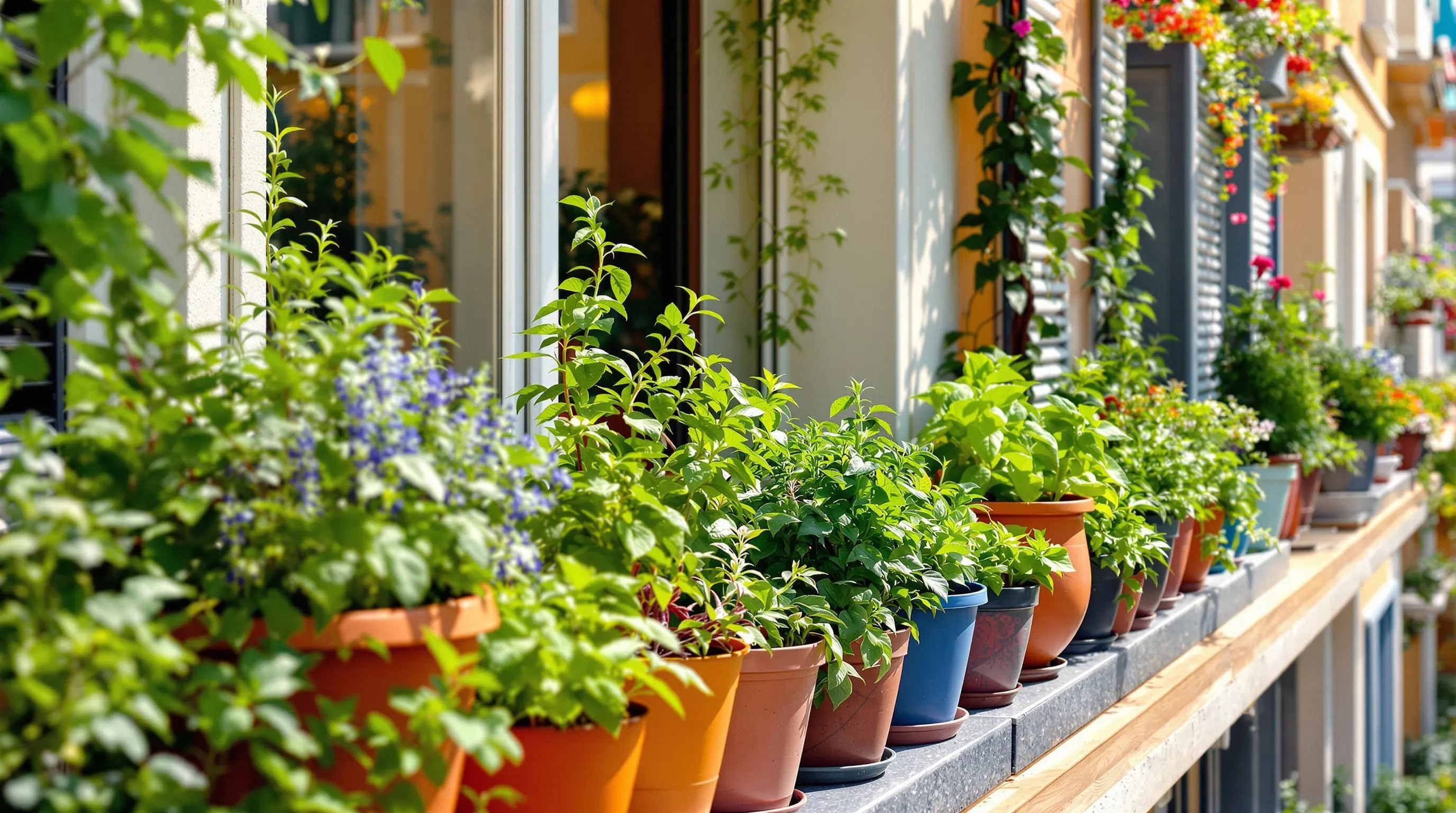
Not all herbs are created equal when it comes to balcony gardening. Choosing the right herbs for your exact balcony conditions will ensure a thriving garden that provides fresh flavors year-round.
Sun-Loving Herbs for South-Facing Balconies
South-facing balconies receive abundant sunlight, creating the perfect environment for Mediterranean herbs that crave heat and direct sun. Rosemary thrives in these conditions, developing more intense aromatic oils when bathed in 6-8 hours of direct sunlight. Thyme performs exceptionally well, requiring minimal water and producing prolific growth in sunny spots. Basil varieties, especially Genovese and Thai basil, flourish with plenty of sunshine, developing fuller flavors when exposed to direct light. Sage appreciates the warmth of south-facing spaces, producing silvery-green leaves packed with flavor. Oregano becomes more pungent and flavorful when grown in full sun, making it an excellent choice for pizza and pasta dishes. Remember to water these sun-lovers in the morning or evening to prevent water evaporation and ensure your containers have proper drainage to avoid root rot in these heat-loving herbs.
Shade-Tolerant Herbs for North-Facing Spaces
North-facing balconies don’t have to miss out on fresh herbs even though their limited direct sunlight. Mint varieties thrive in shadier conditions, often growing too aggressively in full sun locations. Parsley adapts wonderfully to partial shade, producing lush, dark green leaves even with just 3-4 hours of indirect light. Chives grow reliably in lower light conditions, providing mild onion flavor year-round with minimal fuss. Cilantro actually prefers cooler, less sunny spots, as intense heat causes it to bolt quickly. Lemon balm produces aromatic leaves in partial shade, attracting beneficial pollinators while providing citrusy notes for teas and desserts. These shade-tolerant herbs typically require less frequent watering than their sun-loving counterparts, but you’ll still need to monitor soil moisture regularly as north-facing locations can sometimes retain dampness longer, potentially leading to root problems if drainage isn’t adequate.
Creative Upcycled Container Ideas for Sustainable Herb Gardens
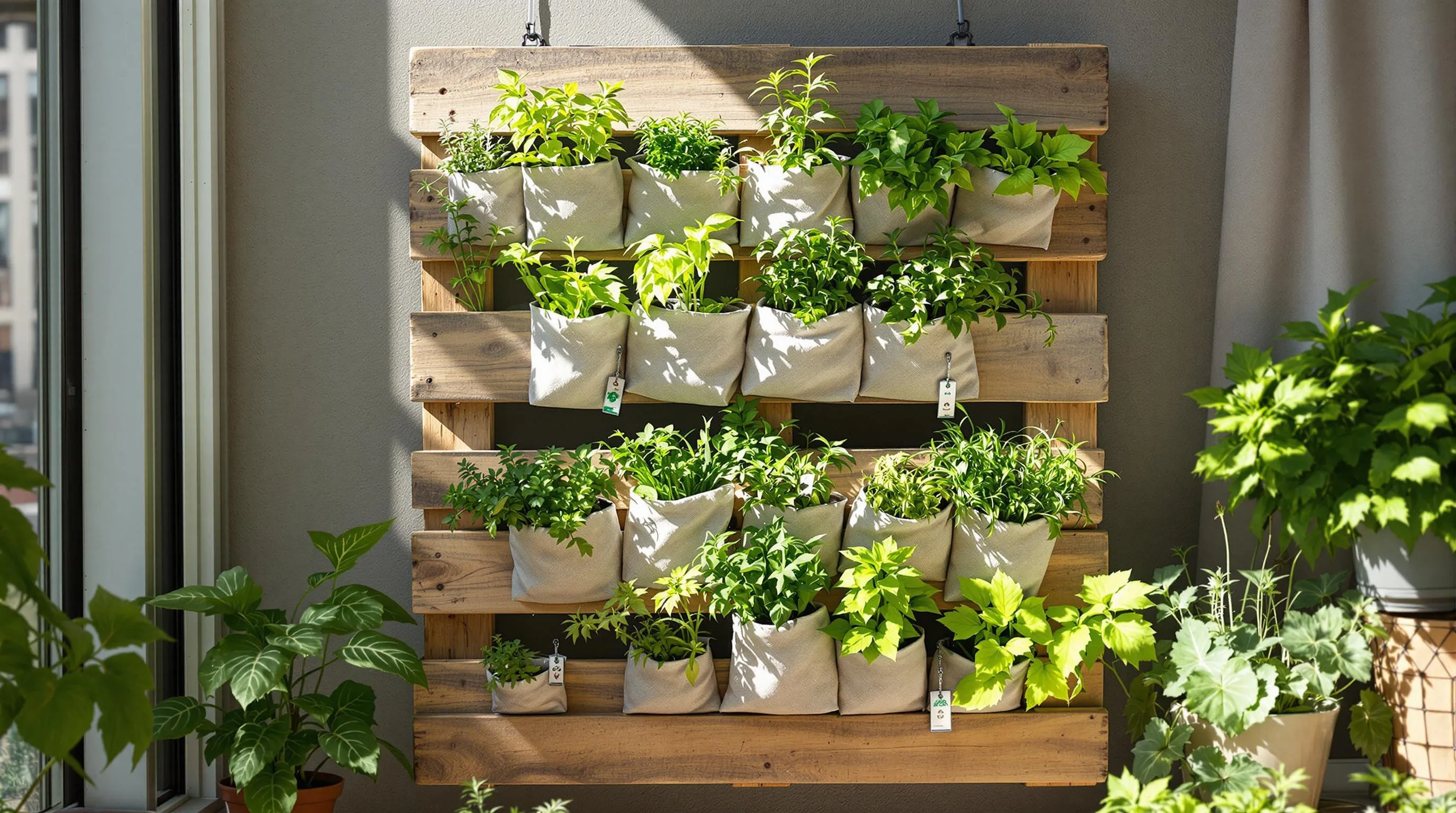
Transforming everyday items into herb planters isn’t just budget-friendly—it’s also an eco-conscious way to reduce waste while creating a unique balcony garden. These upcycled containers add character to your space while giving new life to items that might otherwise end up in landfills.
Repurposed Kitchen Items as Herb Planters
Your kitchen is a treasure trove of potential herb planters waiting to be discovered. Old teapots make charming containers for mint or thyme, with their spouts providing natural drainage points. Transform tin cans by painting them vibrant colors and drilling drainage holes for a rustic-modern look. Coffee mugs work perfectly for small herbs like chives or oregano—just add a layer of pebbles at the bottom for drainage. Colanders serve as ready-made planters with built-in drainage, ideal for herbs that don’t like wet feet such as rosemary. Even unused ceramic bowls can become stunning herb homes when filled with proper potting mix and herbs with similar water needs. These kitchen items not only reduce waste but also bring a personal touch to your balcony herb garden that store-bought containers simply can’t match.
DIY Pallet Herb Gardens for Vertical Growing
Wooden pallets offer an excellent framework for vertical herb gardens, maximizing your balcony’s growing space while repurposing materials that businesses often discard. Start by sanding rough edges and treating the wood with non-toxic sealant to protect against moisture. Attach industry fabric to the back and bottom using a staple gun, creating pockets where you’ll add soil and herbs. Mount your pallet garden against a wall or railing, ensuring it receives adequate sunlight for your chosen herbs. The horizontal slats create perfect rows for different herb varieties, with the lower pockets ideal for trailing herbs like creeping thyme or oregano. You can further customize your pallet garden by painting it to match your balcony décor or adding small identification tags for each herb. This space-efficient solution transforms industrial waste into a productive vertical garden that makes harvesting herbs remarkably convenient.
Smart Watering Solutions for Balcony Herb Gardens
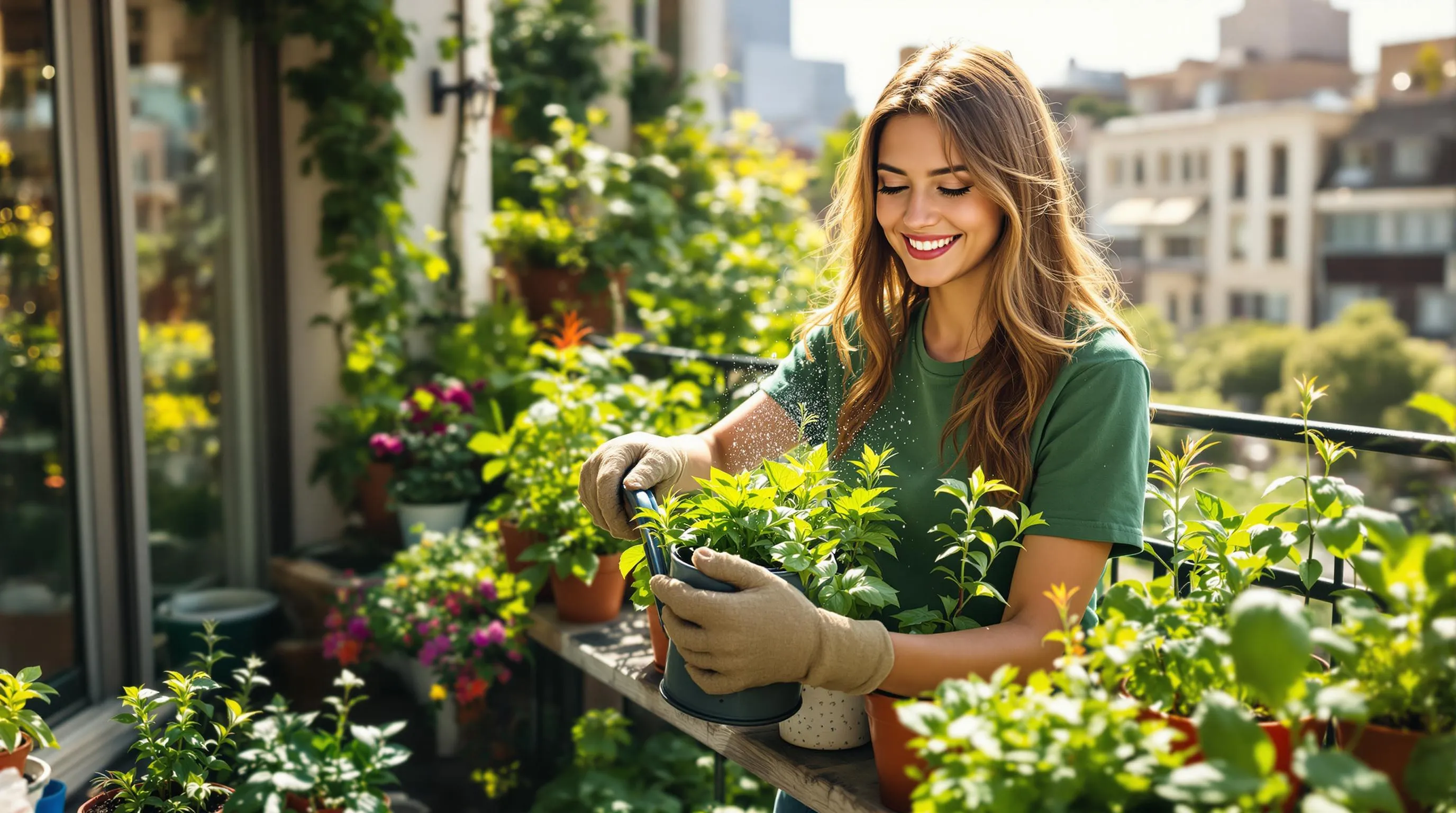
Maintaining optimal moisture levels is crucial for a thriving balcony herb garden, especially in urban environments where time constraints and environmental considerations come into play.
Drip Irrigation Systems for Busy Urban Gardeners
Drip irrigation systems offer a time-saving solution for balcony herb gardens, delivering water directly to your plants’ roots with minimal waste. These systems typically include a reservoir, tubing, and emitters that release water slowly at scheduled intervals. You’ll find various options available, from simple gravity-fed systems to programmable setups with timers that automatically water your herbs while you’re away. A basic DIY drip system costs between $20-$40 and can be installed in under an hour without specialized tools. Most systems can be customized to your exact layout, whether you’re growing herbs in hanging baskets, vertical planters, or traditional pots. With water delivered precisely where needed, your basil, thyme, and rosemary will receive consistent moisture without the risk of over or under-watering.
Water Conservation Techniques for Eco-Conscious Growers
Carry out water-saving practices in your balcony herb garden to reduce consumption while keeping plants healthy. Self-watering planters use capillary action to draw water from a reservoir as needed, reducing water usage by up to 30% compared to traditional watering methods. Collect rainwater in small balcony-friendly barrels (2-5 gallons) fitted with spigots for easy access. Apply mulch—such as small pebbles, coconut coir, or bark chips—in a thin 1-inch layer on soil surfaces to slow evaporation and maintain moisture levels longer. Group herbs with similar water requirements together; place moisture-loving cilantro and basil in one area, while drought-tolerant rosemary and thyme can share another space. Finally, water during early morning or evening hours to minimize evaporation, saving up to 25% of your water compared to midday watering while ensuring your herbs receive maximum benefit from every drop.
Seasonal Planning for Year-Round Balcony Herb Harvests
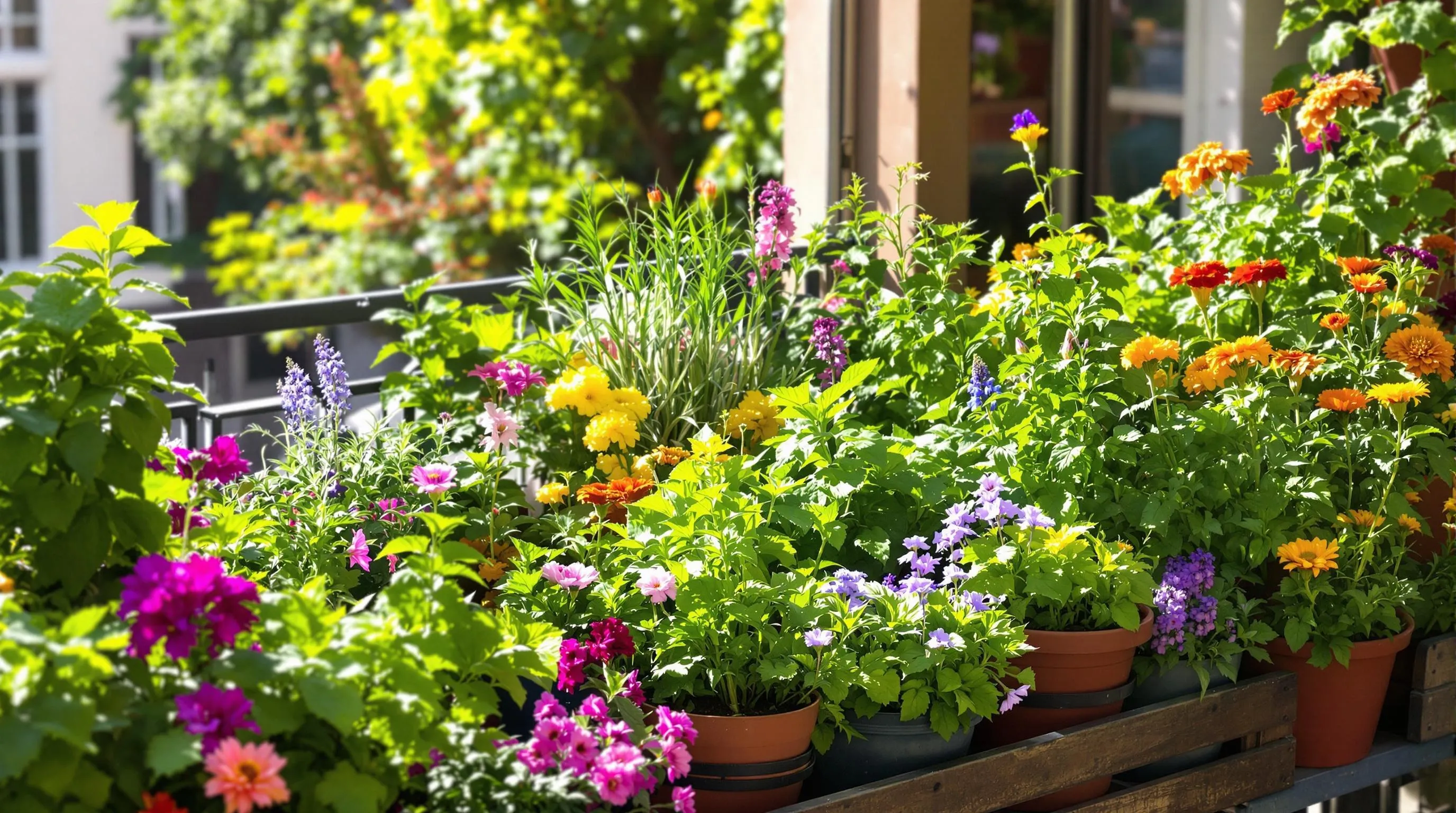
Spring and Summer Herb Selection
Your balcony herb garden can flourish during warmer months with heat-loving varieties that thrive in spring and summer conditions. Basil becomes a star performer during this time, producing abundant aromatic leaves perfect for pestos and summer salads. Cilantro, dill, and summer savory also peak during these seasons, offering fresh flavors for your seasonal cooking. Plant fast-growing herbs like borage and calendula, which produce edible flowers that add color to both your balcony and summer dishes. For maximum productivity, schedule succession plantings of quick-growing herbs like basil and cilantro every 3-4 weeks to ensure continuous harvests throughout the growing season. Remember to water more frequently during hot weather, preferably in the early morning to reduce evaporation and prevent leaf scorching.
Fall and Winter Hardy Herbs
Transform your balcony into a year-round herb source by incorporating cold-tolerant varieties that withstand cooler temperatures. Rosemary, thyme, and sage become particularly aromatic during fall and continue producing through mild winters in many regions. Evergreen herbs like winter savory and certain varieties of oregano maintain their flavor even as temperatures drop. For extreme cold protection, use fabric row covers or small cloches to shield delicate herbs, extending their productive season by several weeks. Consider moving potted perennial herbs closer to your building wall where they’ll benefit from radiated heat. Cold-season herbs like parsley and cilantro often experience a flavor revival during cooler weather, becoming sweeter and more intense than their summer counterparts. For the darkest winter months, supplement outdoor growing with compact indoor herbs like chervil and chives that thrive on bright windowsills, ensuring you’ll never be without fresh flavors regardless of the season.
Combating Common Balcony Herb Garden Challenges
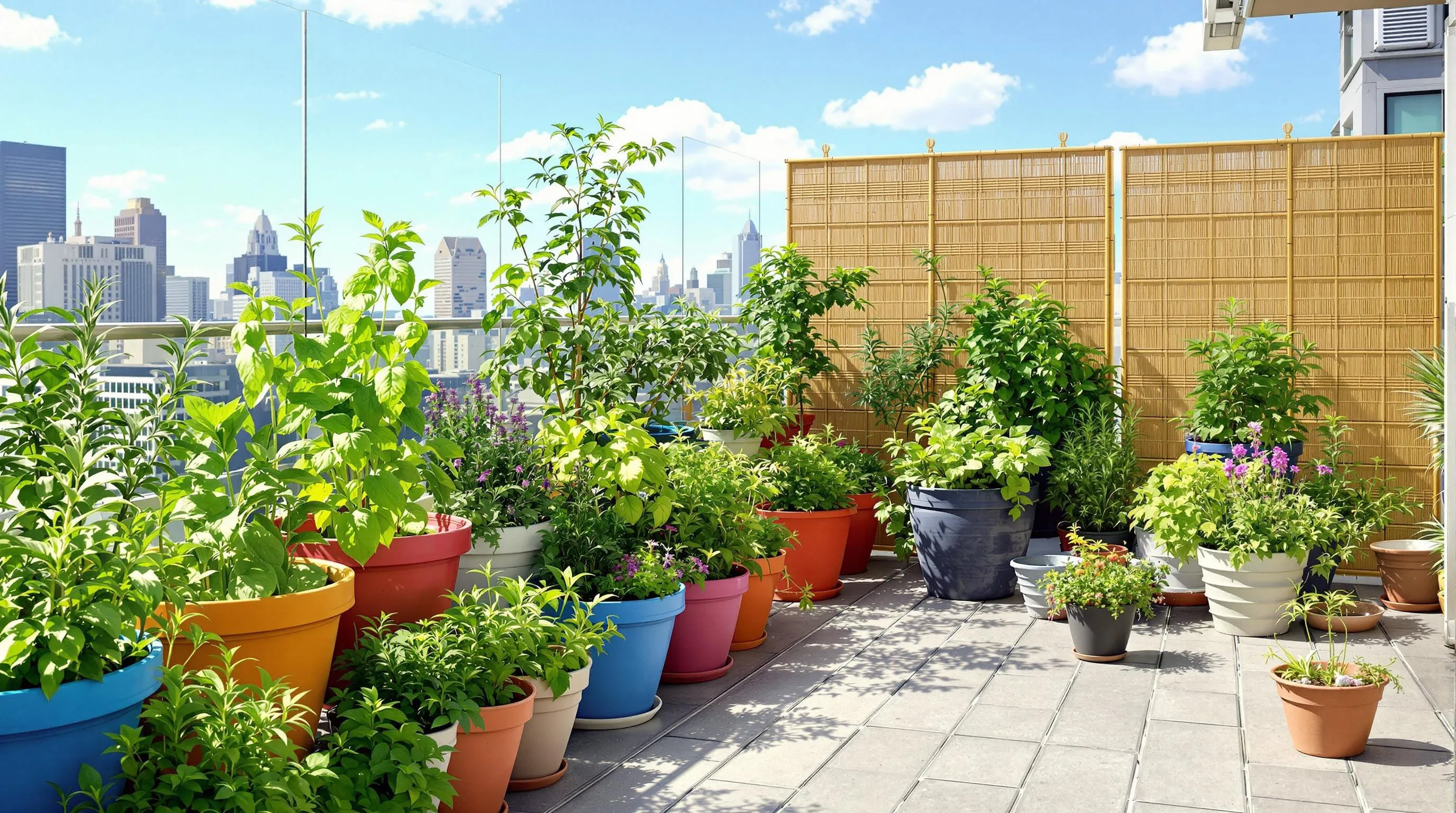
Wind Protection Strategies for Exposed Balconies
Wind can wreak havoc on your balcony herb garden, causing soil to dry out quickly and damaging delicate plants. Install windbreak answers like clear acrylic panels or bamboo screens to shield your herbs while maintaining light exposure. For quick protection, position taller, sturdier plants like rosemary or lavender on the windward side to create a natural barrier for smaller herbs. Grouping containers closely together also helps create a microclimate that reduces wind impact. Consider using heavier pots that won’t topple over and securing hanging planters with additional hooks or wires. During extreme weather, temporarily move vulnerable herbs indoors or create temporary shelters using garden fabric attached to the balcony railing.
Pest Management in Urban Environments
Urban balcony gardens aren’t immune to pests, but you can manage them effectively without harsh chemicals. Introduce beneficial insects like ladybugs and lacewings that prey on common herb pests such as aphids and spider mites. Companion planting works wonders—intersperse herbs like mint and basil that naturally repel certain insects throughout your garden. Create simple DIY traps using yellow sticky cards for flying pests or shallow dishes of beer to catch slugs. Regularly inspect your herbs, paying special attention to leaf undersides where pests often hide. For immediate intervention, use organic answers like neem oil spray or insecticidal soap that won’t contaminate your edible herbs. Maintain good air circulation between plants and avoid overwatering, as damp conditions attract many common pests that can quickly spread in confined balcony spaces.
Design Tips for an Aesthetically Pleasing Herb Display
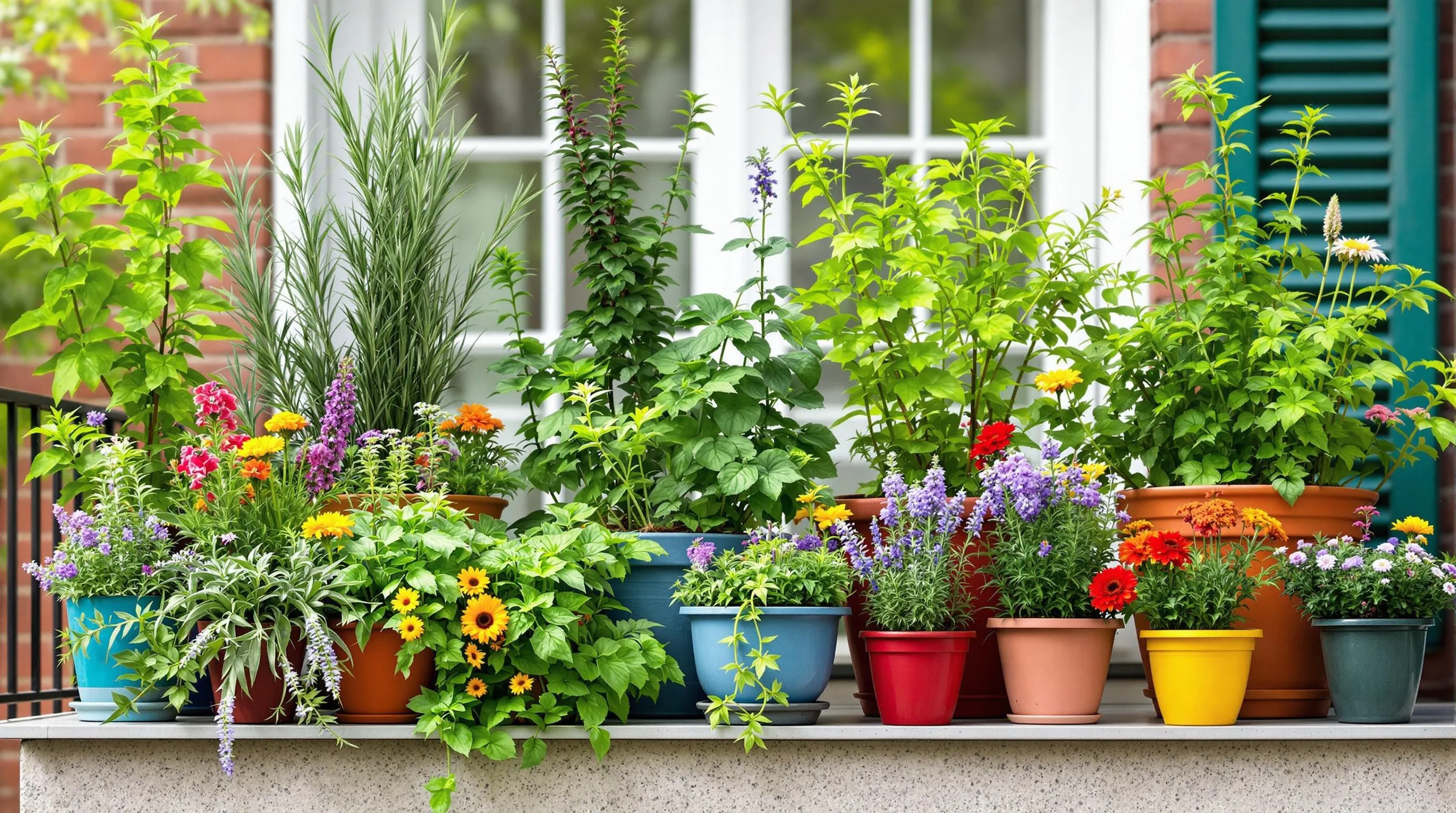
Color Coordination with Flowering Herbs
Transform your balcony herb garden into a visual masterpiece by incorporating flowering herbs that create stunning color combinations. Purple-flowering herbs like lavender, chives, and sage can create a calming palette when paired with white-flowering chamomile or cilantro. For a vibrant display, combine yellow calendula flowers with blue borage blooms. You’ll maximize visual impact by grouping herbs with similar color profiles together in clusters rather than scattering them randomly. Consider seasonal color changes too—oregano and thyme develop beautiful purple hues in fall, while variegated herbs like pineapple mint or tricolor sage add year-round color interest even when not flowering. Try planting nasturtiums or violas among your culinary herbs for edible flowers that provide both function and ornamental value.
Arranging Herbs by Height and Texture
Create visual depth in your balcony herb garden by strategically arranging plants according to their growth habits. Position taller herbs like rosemary, bay laurel, and dill toward the back of your display, then place mid-height plants like basil and sage in the middle, with trailing herbs such as thyme and oregano at the front or in hanging containers. This tiered approach prevents smaller plants from being overshadowed while creating a lush, layered appearance. Contrast different leaf textures for added visual interest—pair the feathery foliage of dill or fennel with the broad leaves of basil or the needle-like foliage of rosemary. Consider growth rates when planning your arrangement, placing aggressive spreaders like mint in separate containers to prevent them from overtaking more delicate neighbors. This thoughtful organization not only looks professional but also improves air circulation between plants, promoting healthier growth.
Tech-Forward Solutions for Modern Balcony Herb Gardens
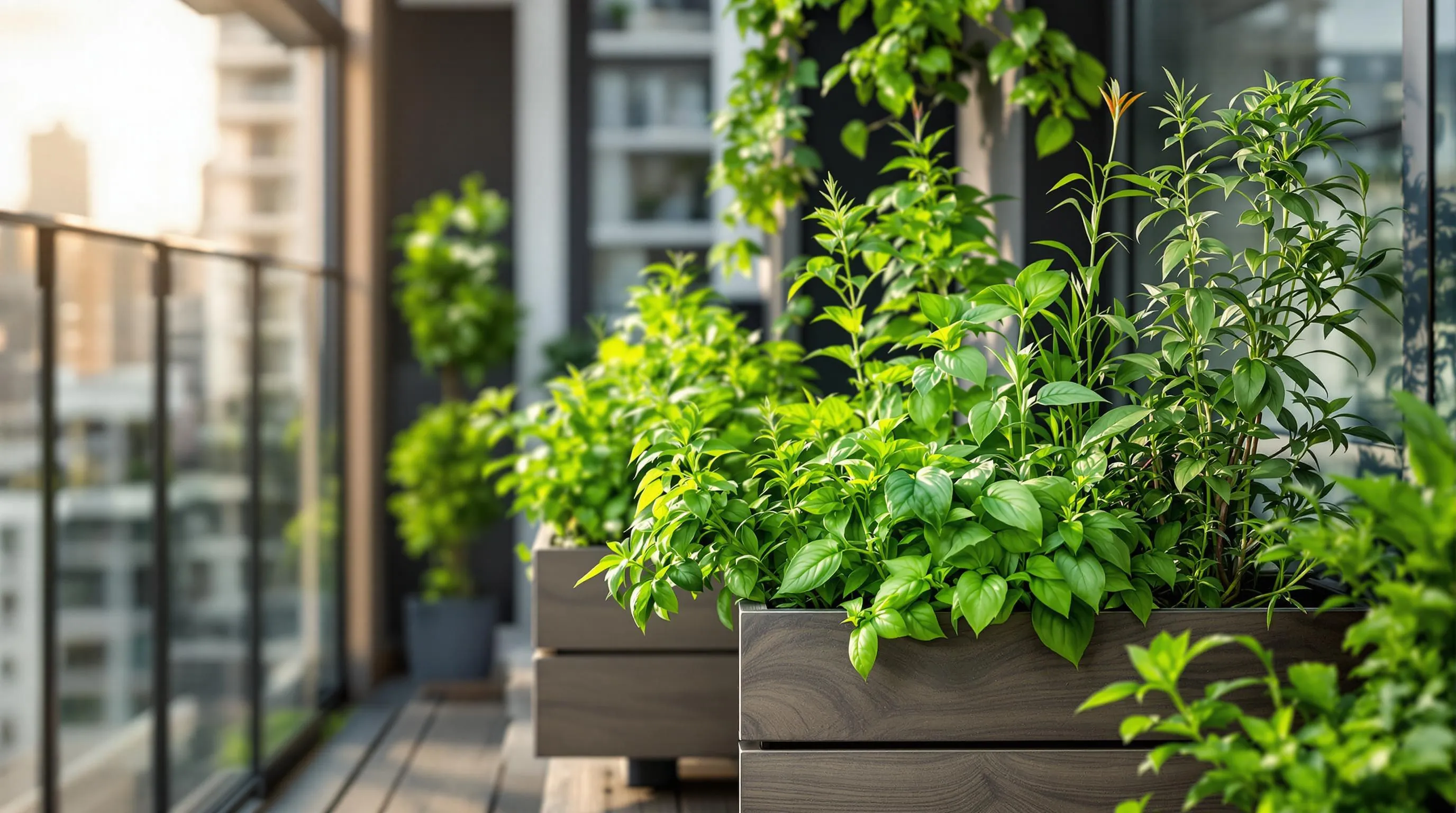
Today’s balcony herb gardens can benefit from cutting-edge technology that takes the guesswork out of plant care. These innovative answers can help even novice gardeners achieve impressive results while fitting perfectly into busy urban lifestyles.
Smart Sensors and Automated Watering Systems
Smart plant sensors have revolutionized balcony herb gardening by monitoring crucial growing conditions in real-time. These devices track soil moisture, light exposure, temperature, and nutrient levels, sending alerts directly to your smartphone when your herbs need attention. Products like Plantlink, Gro Water Sensor, and ECOWITT Soil Moisture Meter can detect when your basil is thirsty or your mint is getting too much sun, eliminating the guesswork from herb care. Pair these sensors with automated watering systems like the Gardena Smart Irrigation Control or Orbit B-hyve for a truly hands-off approach. These systems create customized watering schedules based on real-time weather data and plant needs, delivering precisely the right amount of water through drip irrigation. For tech-savvy gardeners with multiple herbs, consider the Eve Aqua Smart Water Controller that integrates with home automation systems, allowing you to create sophisticated watering routines that adjust seasonally or pause during rainy weather.
Apps to Track and Manage Your Herb Garden Growth
Herb gardening apps provide valuable guidance and tracking capabilities right at your fingertips. Specialized applications like Planta, Greg, and PictureThis offer personalized care schedules, plant identification features, and troubleshooting advice for your exact herbs. These apps send timely reminders for watering, fertilizing, and harvesting based on your local climate conditions and the exact needs of herbs like rosemary, thyme, or cilantro. Many apps now include growth tracking features that let you document your herbs’ progress through photos and notes, creating a visual journal of your garden’s development. Some advanced gardening apps even connect with weather services to alert you about upcoming conditions that might affect your balcony herbs, such as extreme heat waves or cold snaps. For community-minded gardeners, apps like GardenTags and SmartPlant connect you with fellow herb enthusiasts who can share advice and answers exact to balcony growing challenges.
Harvesting and Preserving Tips for Balcony-Grown Herbs
Your balcony herb garden offers endless possibilities for improving your living space and culinary adventures. Whether you’ve opted for vertical planters space-saving containers or tech-savvy answers you’ve created a sustainable source of fresh flavors right outside your door.
Start harvesting your herbs once they’re established taking only what you need to encourage continued growth. Preserve your abundant harvests by drying bundles hanging upside down freezing chopped herbs in ice cube trays or creating herb-infused oils.
Remember that your balcony herb garden is uniquely yours—adapt these ideas to fit your space sunlight conditions and lifestyle. With proper care and creativity your urban oasis will reward you with aromatic herbs year-round transforming both your meals and your outdoor space into something extraordinary.





